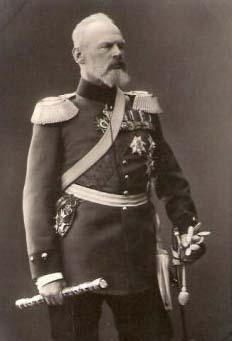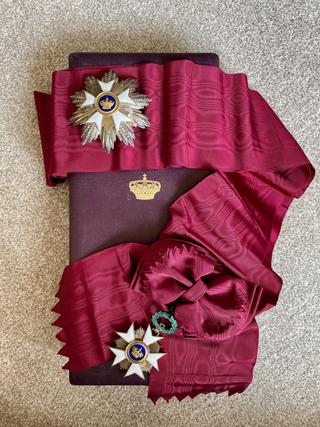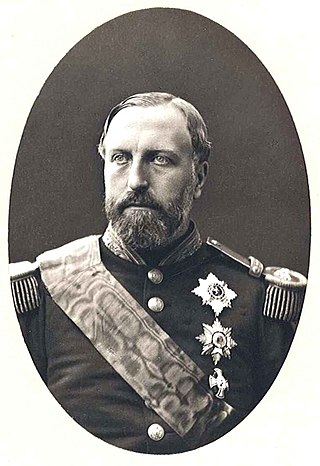This article has an unclear citation style.(June 2017) |
Baron Edmond Ferdinand Felix Euchariste Marie Ghislain de Gaiffier d'Hestroy was a Belgian Ambassador. [1] Born into a noble family, he served as ambassador in Paris, where he died in 1935.
This article has an unclear citation style.(June 2017) |
Baron Edmond Ferdinand Felix Euchariste Marie Ghislain de Gaiffier d'Hestroy was a Belgian Ambassador. [1] Born into a noble family, he served as ambassador in Paris, where he died in 1935.

Prince Carl of Sweden and Norway, Duke of Västergötland was a Swedish prince. Through his daughters, for whom he arranged excellent dynastic marriages, he is an ancestor of several members of European royal houses today, including the reigning monarchs King Harald V of Norway, King Philippe of Belgium, and Grand Duke Henri of Luxembourg.

Prince Leopold of Bavaria was born in Munich, the second son of Prince Regent Luitpold of Bavaria (1821–1912) and his wife Archduchess Augusta of Austria (1825–1864). He was a Field Marshal (Generalfeldmarschall) who commanded German and Austro-Hungarian forces on the Eastern Front in World War I.

The Order of the Crown is a national order of the Kingdom of Belgium. The Order is one of Belgium's highest honors.

Prince Lorenz of Belgium, Archduke of Austria-Este is a member of the Belgian royal family as the husband of Princess Astrid of Belgium. He is the head of the House of Austria-Este, a cadet branch of the House of Habsburg-Lorraine; he has held this position since 1996.

The Order of Saint Charles is a dynastic order of knighthood established in Monaco on 15 March 1858.

Leopold, Prince of Hohenzollern was the head of the Swabian branch of the House of Hohenzollern, and played a fleeting role in European power politics, in connection with the Franco-Prussian War.

William, Prince of Hohenzollern was the eldest son of Leopold, Prince of Hohenzollern and Infanta Antónia of Portugal.

Prince Philippe of Belgium, Count of Flanders, was the third born and second surviving son of King Leopold I of Belgium and Louise d'Orléans. He was the brother of Leopold II of Belgium and Empress Carlota of Mexico.

The Order of Saint Stephen was an order of chivalry founded in 1764 by Maria Theresa. In 1938, Miklós Horthy took the rights and activities of Grand Master as Regent of Hungary. The name of the Order changed to the Royal Hungarian Order of Saint Stephen. The Order was terminated at the time of the proclamation of the Second Hungarian Republic in 1946. It was recreated in 2011 as the Hungarian Order of Saint Stephen, and to this day remains the highest order in Hungary.

The Military Order of St. Henry was a military order of the Kingdom of Saxony, a member state of the German Empire. The order was the oldest military order of the states of the German Empire. It was founded on October 7, 1736 by Augustus III, King of Poland and Elector of Saxony. The order underwent several more revisions over the course of the 19th and early 20th centuries. It became obsolete with the fall of the Saxon monarchy in the wake of Germany's defeat in World War I.

Prince Friedrich Leopold of Prussia was a son of Prince Frederick Charles of Prussia and Princess Maria Anna of Anhalt-Dessau, married in 1854.

Frederick I was a German prince of the house of Ascania who ruled the Duchy of Anhalt from 1871 to 1904.

Wilhelm Gustav Karl Bernhard von Hahnke was a Prussian Field Marshal, and Chief of the German Imperial Military Cabinet from 1888 to 1901.

Melchior Hubert Paul Gustav Graf von Hatzfeldt zu Wildenburg was a German diplomat who served as ambassador to the United Kingdom from 1885 to 1901. He was also envoy to Spain and the Ottoman Empire, foreign secretary, and head of the Foreign Office. He is best known for signing the Yangtze Agreement in 1900.

Oswald Samuel Konstantin Freiherr von Richthofen, a German diplomat and politician, served as Foreign Secretary and head of the Foreign Office from 23 October 1900 to 17 January 1906.

Friedrich Graf von Beck-Rzikowsky, sometimes Friedrich Beck, was an Austrian Generaloberst and Chief of the general staff of the Imperial and Royal army from 1881 to 1906.

Maurice César Joseph Pellé was a French général de division, leader of the French Military Mission to Czechoslovakia and first Chief of staff of Czechoslovak Army from February 1919 to January 1921.
Charles-Marie-Leon, Count d'Ursel (1848–1903) was a Belgian politician of the Catholic Party.

Charles Maximilien, Count de Lalaing (1856–1919) was a Belgian diplomat.